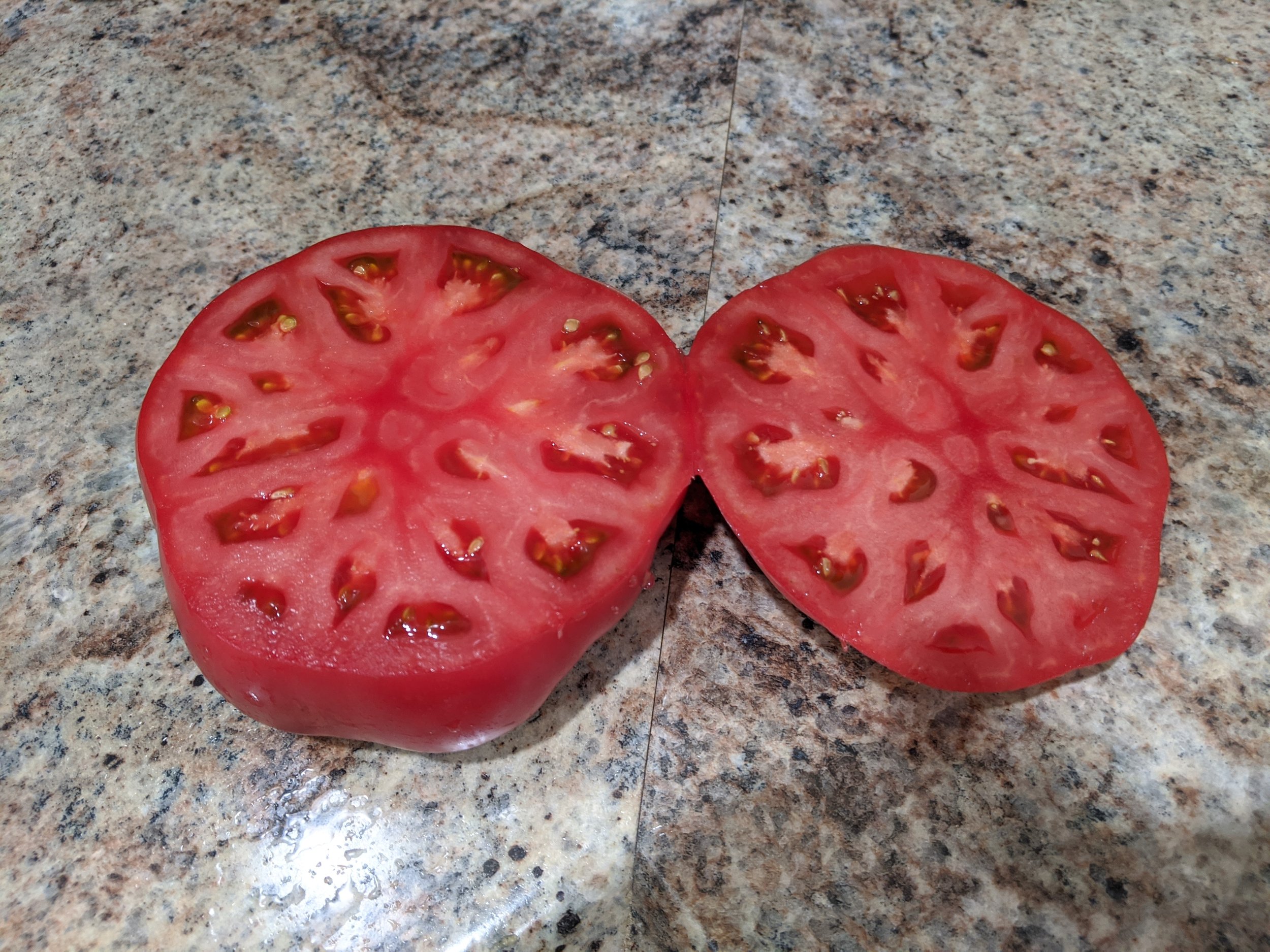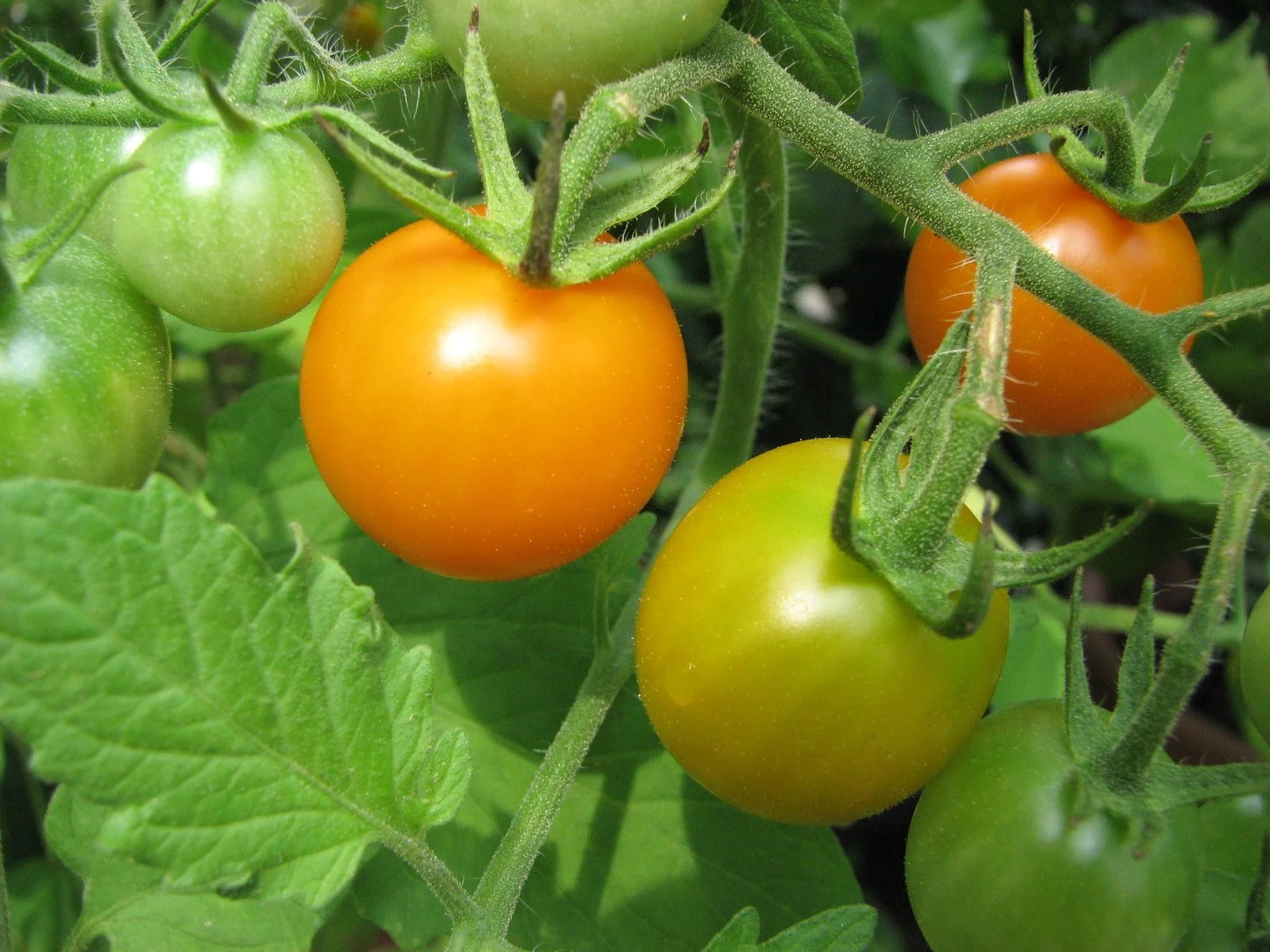A specimen of Polish, described below, tomato #89 in my collection
Tomato #100 from my collection is in sight! Let’s continue the trip through my seed numbers, vials and packets. Going down memory lane sure is interesting for me - hope it is for you as well.
_______________
Tomato 81 -Bisignano #2 - This is one of the stars of my tomato collection, obtained by SSE member Elaine Reidy of Massachusetts in 1988. She claims that the seeds came from a Mr. Bisignano, a finalist in the Victory Garden TV contest of 1984 (a show I used to watch often - Jim Crockett’s books were a foundation of my early garden library). They are supposedly from Italy in the 1950s. It was a star in my 1988 garden, with first ripe fruit in 67 days, a total harvest of 45 tomatoes averaging half a pound. The plant produced 23 pounds and the flavor was really excellent. A unique aspect is that the fruit shape varies from oblate/beefsteak to heart/plum, on the same plant. I love this one so much it was featured in my book, Epic Tomatoes. This is a tomato that although balanced in flavor allows the tartness to show. It’s perfect for slicing and eating as well as cooking/sauces.
Tomato 82 - Egg - This not particularly creatively named tomato was obtained from Gleckler in 1988 but I never did get around to growing it. It is a variety they carried since the late 1950s. The Gleckler catalog stated “Something altogether different than the ordinary tomato. An extremely heavy fruit setter, the size and shape of a medium-size chicken egg, and having only a very tiny stem scar. Fruits possess extremely high solids of blood-red color, with a very sweet delicious flavor. Maturity is mid-season, but bearing and ripening over a very long period. The fruits resist both cracking and sunburn, almost completely. This strain is one of the longest keeping tomatoes after ripe that we have ever seen. Medium size, indeterminate vines with quite heavy foliage. The old saying, "good thing come in small packages," certainly applies to this tomato.”
Tomato 83 - Winsall - This historic tomato has elevated itself in relevance to my hobby. It is a variety that was released by the Henderson Seed Company in 1924 with the name “Number 400”, with a contest launched to give it a name. It was supposedly a selection from their 1890s release Ponderosa (itself released as “Number 400” prior to a customer providing the eventual name). It is a curious name that I think would be more appropriate as “Wins All”, but it was their decision. When we sold seedlings in the late 1990s in Raleigh, it was one of the varieties we carried. An elderly gentleman was transfixed when he noted the plant tag, telling us that he thought the tomato was long gone, not having seen it since he was very young and gardening with his father. He came back to obtain seedlings from us for several years. I told this story at the outset of the 2016 taped Growing a Greener World episode, by Joe Lamp’l, and through that, I am often asked for seeds. I first grew it in 1993 and really enjoyed it - not my favorite regular leaf pink type (that would be Dester), but certainly better in flavor and performance than German Johnson. I grew it last year in a straw bale so it could be featured in the tomato course Growing Epic Tomatoes. It did just wonderfully, with a great yield of one pound average smooth oblate pink fruit - I rated it a solid 7.5.
Tomato 84 - Hunt Family Favorite - Obtained from SSE member Edmund Brown of Missouri in 1988, alas, I’ve never gotten to experience the true Hunt Family Favorite, described as a large pink tomato. I grew it in 1989, and though obviously crossed (it was an oval scarlet tomato), it was a garden standout. First fruit coming in at 57 days, the plant produced 57 tomatoes with an average weight of half pound - 29 pounds from that one plant, and the flavor was really full and special, receiving an A. I never did return to it again, and didn’t resume my search for the authentic pink strain. It supposedly dates to the Hunt family of Missouri in the early 1900s.
Tomato 85 - Valiant - I was sent this historic, early US commercial variety by Florida SSE member Gary Staley in 1988. Alas, I never did grow it. It is a Stokes Seed Company 1937 introduction. From that catalog description it is a determinate variety with relatively sparse foliage and maturity in season with Earliana. It is noted for being quite solid, nearly round, scarlet in color and averaging 6 ounces. It clearly was bred to be a commercially farmed variety to supply the tomato industry.
Tomato 86 - Purple Smudge - This rather weird-o tomato, which I never grew out, also came from Gary Staley. The name came from a phenomenon similar to what we see in the recent anthocyanin-rich varieties, the presence of a purplish pigment on the shoulders of fruit exposed to the sun. The seed was originally obtained from USDA germplasm, into which it was donated in 1962. The parentage is quite complex, but the purple shoulder smudge apparently came from one of the parents, a Lyco. Peruvianum - a different species of the tomato.
Tomato 87 - Golden Oxheart - The third of the Gary Staley tomatoes sent to me in 1988, this was actually a tomato I really enjoyed in my early tomato gardening. I grew it in 1989, and the first tomatoes were harvested in 77 days. The plant was on the compact side, and I picked 27 tomatoes at an average weight of 9 ounces, giving a plant yield of 15 pounds. I enjoyed the full, balanced flavor and rated it an A. The fruits were typically smooth and round. Gary got the seeds from Fax Stinnett of Oklahoma in 1982. I didn’t see a heart-shaped nature in the fruit, and the plant didn’t have the weepy foliage characteristic of heart shaped varieties. The closest tomato in color and shape of my knowledge is the Jubilee/Sunray types. No matter, the tomato was delicious. Writing this reminds me to seek it out again so that I can experience it again. The last time it was in my garden was 1993, and it is doubtful nearly 30 year old seed will germinate.
Tomato 88 - Stone - This tomato was also sent to me by Edmund Brown. Stone is a historic variety, released by the Livingston Seed Company in 1889. I didn’t get to grow it until 1991. I recall an indeterminate plant with radial-crack-prone scarlet fruit that were on the small side - 3-4 ounces. My expectations of Stone. Victory Seeds reports tomatoes in the 6-8 ounce range from seed I sent Mike - it is time to get some seed back and give it another try. Another source would be the USDA germplasm collection, which does carry a sample. I have no recollection of the flavor from that 1991 attempt.
Tomato 89 - Polish - Here is a true superstar tomato. This really is about as good as a tomato can be, and I’ve always considered this to be as flavorful as Brandywine, but with a more consistent performance year to year. I requested the variety from Bill in 1989 and grew it in that year’s garden in Pennsylvania - and many others in between, in Raleigh - and the last two years here in Hendersonville. First, the 1989 performance data…first fruit harvested in 73 days, with 23 tomatoes at an average weight just under one pound, nearly 23 pounds from the plant with a solid A in flavor. A few things set Polish apart. When the first true leaves emerge, they are the most distinct, rounded, potato leaf form I’ve seen. It is such a happy, vigorous seedling. The variety seems to be happy with a range of conditions, excelling in all of my gardens. Bill obtained a seedling of this variety from a roadside stand in Trenton, New Jersey. The seeds came from Agnes Lynn of Conyngham, Pennsylvania, and was said to have originated in Poland. Though a pink tomato (red flesh, clear skin), I actually found it listed in the “red” section of the SSE yearbook. Many gardeners use the terms “red” and “pink” incorrectly, and I am convinced different people see those two colors quite differently. As for the flavor…it has it all - it has everything - tartness, sweetness, intensity, complexity, as well as the most enticing juicy texture.
Tomato 90 - Old Brooks - This was another Edmund Brown sourced seed in 1988. I have some data on my 1989 grow out of the variety in my West Chester, PA garden. Producing first fruit in 69 days, I harvested 19 tomatoes at an average weight of 11 ounces. The 12.7 pound plant yield is on the low side, and I recall this being quite a small plant. The scarlet oblate tomatoes did have a nice, balanced flavor and received an A-. It seems to have entered the SSE in 1984 by a member with the name code MS FO C.
___________
Some real favorites emerged from this group. Only a few went ungrown. I also learned about the possibility of receiving crossed or incorrect seeds, with my result from Hunt Family Favorite. But….Polish! I can’t imagine a summer going by without this gem in my garden. Thanks, Bill Ellis!
The next set, which will take us to Tomato #100 (actually it will take us to #102, because a few numbers in this set were used for saved seed), has a few really important ones, such as Whopper hybrid, the historic Chalk’s Early Jewel, and the spectacular yellow monster Hugh’s.
Once I reach that century mark, I will take a pause and do a highlight post to summarize my feelings about reviewing the first 100 tomatoes of my now out-of-control, huge, seed collection.
Marlin and Betts resting after their hike at DuPont






















